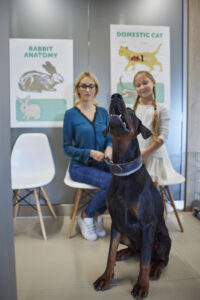Barks Blog
Overcoming Fear of Vet Visits
By Susan Nilson and Angelica Steinker

Based in Adelaide, Australia, Petra Edwards is currently working on her Ph.D, which focuses primarily on how dogs experience visits to the veterinary clinic while also looking at possible strategies that could be implemented to reduce or prevent stress.
Last year, she and her co-researchers published the papers, Fearful Fido: Investigating dog experience in the veterinary context in an effort to reduce distress and Investigating Risk Factors That Predict a Dog’s Fear During Veterinary Consultationsin an effort to see what measures could be implemented to reduce the levels of fear and/or distress experienced by many dogs when they go to the vet.
There are a number of reasons why stress during veterinary visits is counterproductive, including “the negative impact of stress on long-term health; how frequently a guardian brings their dog to the veterinarian; the veterinarian’s ability to accurately diagnose health concerns; and, stressed dogs can place veterinarians at greater risk of injury.” (Edwards et al., 2019a).
Yet, as the researchers also point out, all dogs will require veterinary care during their lifetime, and each of them will experience their vet visits differently: “From the dog’s perspective a ‘routine’ veterinary visit encompasses walking into a strange place with slippery surfaces, being surrounded by strange sounds, sights, smells, and potentially stressed animals (Hewson, 2014), and then being handled or restrained, while potentially enduring painful or invasive procedures.” (Edwards et al., 2019a).
“At this stage, the research indicates that veterinary visits are stressful for at least some dogs, but we don’t know exactly how common it is,” said Edwards (P. Edwards, personal communication, 2020).
“Previous studies vary in their estimates of prevalence of fear and/or stress at the vet. Last year, we published a study from a large worldwide sample that looked at predictive factors for dogs fearful of their veterinary visits and found approximately 40% of guardians reported their dogs showed some form of fear at the vet, and one in seven dogs displayed severe-extreme fear (Edwards et al., 2019b).
“There are lots of aspects of a veterinary visit that may exacerbate a dog’s fear or stress response, but unfortunately there isn’t enough research yet to confirm which aspects will make the most difference. The review of the literature Fearful Fido: Investigating dog experience in the veterinary context in an effort to reduce distress (Edwards et al., 2019a) provides some useful tables summarizing the different approaches people and veterinary clinics can use to help ameliorate a dog’s stress or fear during veterinary visits.”
Veterinarian’s Office and Staff

BARKS: In my (SN) experience, vet offices are not necessarily always set up with the animal in mind – e.g. reception areas (which can get noisy) may be located right outside the treatment rooms, or the practice entry doorway might be located right next to one of the treatment room doors, causing a potential bottleneck if both doors open at the same time, or the waiting area is set out more for humans than considering the needs of, say, cats who do not want to be near dogs, or dogs who do not want to be situated near other dogs etc., or floors may be slippery.
What can be done in terms of actual setup to avoid adding to already elevated stress levels?
Petra Edwards: I think veterinary clinics often seem to be built with a focus for practicality, or are existing properties converted into a veterinary space, rather than built with companion animals in mind.
Unfortunately, this field of research is only just gaining traction, so we don’t yet know the extent to which clinic layout or surfaces (or smells) play a part in a dog’s fear or stress. Having said that, from a ‘common sense’ perspective, there are lots of things that can be done that might help a dog (or cat) feel more comfortable when they visit the vet. Some of these things include:
• Separate waiting rooms for dogs and cats.
• Using a target or ‘Go Find’ behavior to encourage dogs onto the weigh scale of their own accord (without a lure or forcing them).
• Weigh scale placement and approach – walking toward or practically into a wall might be confusing for some dogs.
• Bringing a nonslip mat for your dog for the wait and consult (especially if they get examined on a slippery table).
• Bringing your dog’s favorite reinforcers – food and/or toys to help keep them calm and focused on you in the waiting room and to use consistently during the consult.
• Sitting away from other dogs or animals while you wait wherever possible.
• Leashes that are 2m (6ft.) or less in length, and that do not extend, can also help your dog not encroach on other animals’ personal space (social interactions are best done in less stressful environments – vet visits aren’t for socialization).
• Asking to be taken straight into a consult room, or waiting outside in the car (weather permitting) until a consult room is ready.
• Paying after the dog is secure in the car (weather permitting).
To that end, simply requesting any of the above might help highlight the importance of the layout and structure of veterinary visits, and hopefully help veterinary staff make those recommendations for other clients too.
BARKS: Same question for treatment rooms that often feature high tables, slippery metal tables, small rooms etc. What physical changes could be made to help alleviate stress?
PE: Again, there’s not much research (yet) on what exactly causes, or will help reduce a dog’s stress in the consult room. However, examining animals where they are most comfortable (wherever possible) will help, especially on the floor (but even in the guardian’s lap).
Affordable non-slip, washable bath mats can help with slippery flooring or tables, and a mat from home might help with calming smells. If the waiting room is empty, perhaps staying in the slightly larger space might be beneficial.
Or guardians or staff might be able to make the space more inviting with some toys on the floor or food treats hidden around the room.

BARKS: What about brightness, color, scent, sounds? How can these be manipulated to make the environment less stressful?
PE: A recent study by Stellato et al. (2019) found that background noise within a clinic was less of an influence on fear responses than the veterinary handling itself.
The impact of sounds should still be considered, as some dogs are more noise sensitive than others, but background noise is unlikely the thing causing a dog’s fear at the vet.
I can’t think of any other studies that looked specifically at brightness, color or scent – it’s likely these things play a small part in what helps dogs recognize veterinary clinic as ‘The Vet,’ but we just don’t know for sure.
I imagine anything that helps make a clinic look or feel more homely will help – less clinical, more plants, sofas, open windows to remove chemical smell, etc. DVM360 has some great recommendations for color palettes and clinic design that might help interested clinics get started.
BARKS: What is your opinion on the use of DAP and classical music/special “dog” (or “cat”) music as destressors?
PE: At the moment, the research on the efficacy of their use is slightly contentious, but I don’t believe there is any evidence that they will make anything worse.
My personal opinion is that these complementary therapies might help the dog feel slightly better, but extreme fears are complex and likely very hard to overcome. I’m sure they will help some dogs with mild stress at the vet cope better, and if they can’t hurt, why not use them?
This is an excerpt from an article that was first published in BARKS from the Guild, November 2020, pp.32-36. Read the full article Overcoming Fear of Vet Visits.
For more great content on all things animal behavior and training, you can sign up for a lifetime, free of charge, subscription to the digital edition of BARKS from the Guild. If you are already a subscriber, you can view the issue here.
Study Article References
Edwards, P.T., Smith, B.P., McArthur, M.L., & Hazel, S.J. (2019a). Fearful Fido: Investigating dog experience in the veterinary context in an effort to reduce distress. Applied Animal Behaviour Science (213) 14-25
Edwards, P.T., Hazel S.J., Browne, M, Serpell, J.A., McArthur, M.L., & Smith, B.P. (2019b). Investigating Risk Factors That Predict a Dog’s Fear During Veterinary Consultations. PLoS ONE 14(7)
References
Stellato, C., Hoffman, H., Gowland, S., Dewey, C.E., Widowski, T.M., & Niel, L. (2019). Effect of high levels of background noise on dog responses to a routine physical examination in a veterinary setting. Applied Animal Behaviour Science 214 64-71
Resources
Lewis, H.E. (2014). Building your veterinary practice color palette. DVM360
Lewis, H.E. (2015). Fear-Free: What you see is not what the cat or dog gets. DVM360
About the Authors
Susan Nilson BA (Hons) DipCABT PCBC-A is editor of BARKS from the Guild and a Reuters-trained journalist with over 10 years’ experience in print journalism in Europe, Asia and the Middle East. She also studied feline behavior under the tutelage of Prof. Peter Neville at the Centre of Applied Pet Ethology (COAPE) in the United Kingdom and completed her diploma in companion animal behavior and training with COAPE in 2005. She is also an accredited professional canine behavior consultant through the Pet Professional Accreditation Board. In 2018, she co-authored Pet Training and Behavior Consulting: A Model for Raising the Bar to Protect Professionals, Pets and Their People.
Angelica Steinker PCBC-A owns and operates Courteous Canine, Inc., a full service pet business and dog school specializing in aggression and dog sports in Tampa, Florida.

